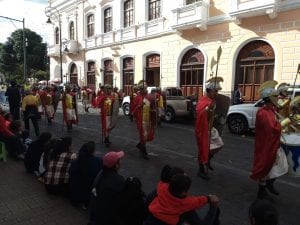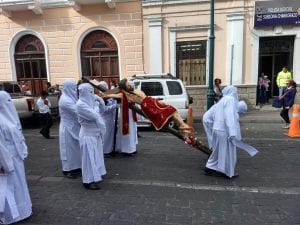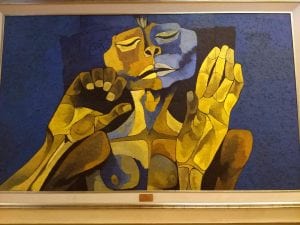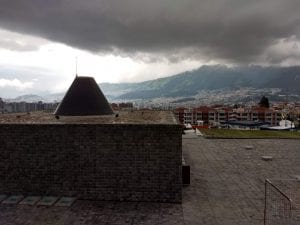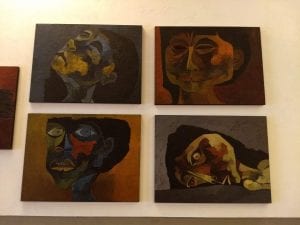Leaning against the white, stucco wall of one of Riobamba’s classic colonial buildings, I watched on, entertained and estranged, as young Ecuadorians with markered-on beards dragged their crosses along the cobblestone, moaning “in agony” over the (faux) flagellation inflicted by their companions in Roman imperial garb. But while some were fully committed to celebrating La Semana Santa (Holy Week), others, decidedly, were not: as one school group processed, I observed one of the students stooped over his joined hands as if to pray, but with his eyes fixed to his watch.
If these two scenes exemplified the poles of interest in the event, I would have placed myself somewhere in the middle of the spectrum. It definitely provoked wonder—over the significance of the whole procession; over the various family and community traditions that fed into it (each “float” or segment of the parade seemed to have its own signature); and over how someone had the genius of using the red-bristled brush of a broom to emulate Roman helmet feathers. But I also felt detached—not only did it not resonate with my lack of a religious upbringing, but it was an event that seemed to repeat the same motifs over and over again without ultimately much variation.
I think that much of the appeal of the event came down to the fact that such a large percentage of the Riobambeño population was participating, and that so many people knew each other. It was fun to watch the crowd wave and call out to their friends in the procession, and to see them laugh as their eyes met. In effect, it gave me a glimpse into the rich web of community connections that is often hidden away from the public sphere by work and routine.
Not only revealing, it also felt constructive. In a time where everything feels so individualized and polarized, with people even refusing to occupy the same physical and digital spaces, this was a moment where everyone was unified around something bigger than themselves. Whether they were moaning in pain or looking at their watches, they were nevertheless still sharing space together. Whether or not they were Catholic, they were still sharing a moment together. Moreover, individuals had come together in advance to build floats and make costumes. One could tell that La Semana Santa was not simply “una semana.”
One thing that has been so interesting to observe in Ecuador is the way that tradition still holds power. It has been noted that in occidental thought, “tradition” tends to have a negative connotation, butting heads against “progress” and change. “Static” is bad—stubborn—they tell us. But does everything always have to change? Maybe it is true that everything is in movement, in flux. But who is to say that that movement cannot retrace its old steps? Can it not be at once generative and regenerative? Think of a spiral: constantly in motion, expanding and shrinking, but with points that can overlap, return to a previous point.
Just food for thought.




